高涛初中英语语法难点
初中英语语法知识难点总结(精编全面)

中考英语语法知识难点大全英语语法知识难点(一)(一)形容词和副词I.要点A.形容词1、形容词的用法形容词是用来修饰、描绘名词的,通常在句中作定语、表语或宾补,有时还可作状语。
如:He is honest and hardworking.I found the book interesting.某些形容词与定冠词连用表示一类人作主语时,谓语通常用复数形式。
如:The rich and the poor live in different parts of the city.The English like to be with their families.多个形容词作定语修饰名词的顺序:冠词+序数词+基数词+性质状态(描述性)+形状大小+新旧老少+颜色+国籍+材料+名词。
如:the second five interesting big new red Chinese wall papers.2、形容词比较等级的形式(1)规则形式一般说来,单音节词及少数双音节词在后加-er; --est 来构成比较级和最高级;其他双音节词及多音节词在前加more, most.如:great-greater-greatestbusy-busier-busiestimportant-more important-(the)most important(2)不规则形式good (well)-better-bestbad (ill)-worse-worstmany (much)-more-mostlittle-less-least(3)形容词比较等级的用法①表示两者的比较,用形容词的比较级+than. 如:He is cleverer than the other boys.This one is more beautiful than that one.②表示两者以上的比较,用"the +形容词最高级(+名词)+of(in) …"如:He is the cleverest boy in his class.③表示两者是同等程度,用"as +形容词原级+as". 如:He is as tall as I.I have as many books as you.④越… 越…例如:The more I learn, the happier I am.⑤You can never be too careful. 越小心越好又如:You can never praise the teacher too highly.你怎么赞扬这个老师也不过分。
初中英语语法难点解析与答疑 (2)

用法:宾语从句 在句子中充当宾 语成分,而定语 从句则充当定语 成分,用于修饰
名词。
结构:宾语从句 和定语从句都有 自己的特定结构, 需要掌握引导词
和句型。
注意事项:在使 用宾语从句和定 语从句时需要注 意时态、语序和 引导词的正确使
用。
虚拟语气和情态动词
虚拟语气:表示与实际情况相反的情况,常常出现在if条件句和wish后的宾语从句 中。
动词的时态和语态
一般现在时:表示习惯性、经常性、普遍性的动作或状态 现在进行时:表示正在进行的动作或状态 现在完成时:表示已经完成的动作或状态,强调对现在的影响 现在完成进行时:表示从过去某个时间开始一直持续到现在的动作或状态
形容词和副词的比较级和最高级
定义:形容词和 副词的比较级和 最高级是英语语 法中的难点之一, 需要掌握如何正 确使用它们。
引导词:宾语从句通常使用that、what等引导词;定语从句通常使用which、that等引导词。
先行词:宾语从句的先行词没有特别限制;定语从句的先行词通常是名词,也可以是代词。
虚拟语气和情态动词的用法有哪些?
虚拟语气:表示与实际 情况相反的情况,常常 用在表达假设、祝愿、 请求等语境中。
情态动词:表示推测、 能力、必要等含义,常 见的情态动词有can、 may、must、should等。
用法:比较级用 于比较两个事物 之间的差异,最 高级用于描述三 者或三者以上中 最突出的一个。
变化规则:形容 词和副词的比较 级和最高级有规 则和不规则的变 化形式,需要牢 记。
注意事项:使用 比较级和最高级 时需要注意语境 和语气,避免产 生歧义或语气不 当。
宾语从句和定语从句
定义:宾语从句 和定语从句是英 语语法中的两种 从句类型,用于 修饰主句中的名
初中英语语法9大难点

初中英语语法9大难点1宾语从句1. 宾语从句的含义充当主句宾语的从句叫做宾语从句。
如:She knew that the teacher had seen the film.她知道这位老师看过这部电影。
“that the teacher had seen the film”做knew 的宾语,同时又是由连接词that 引导的从句,所以它叫做宾语从句。
2. 宾语从句的分类(1)动词宾语从句:顾名思义,它是位于动词后面的宾语从句。
如:He asked whose handwriting was the best in our class.他问我们班上谁的书法最好。
(2)介词宾语从句:顾名思义,它是位于介词后面的宾语从句。
如:I agree with what you said just now.我同意你刚才说的话。
(3)形容词宾语从句:顾名思义,它是位于形容词后面的宾语从句。
如:I am afraid that I will be late. 恐怕我要迟到了。
3. 引导宾语从句的连接词(1)that:没有含义,在宾语从句中不做成分(2)whether/if:表示是否,在宾语从句中不做成分。
I don't know if /whether he still lives here after so many years. 我不知道这么多年后,他是否还住在这里。
(3)连接代词:what, which, who, whom, whose(在宾语从句中做主、宾、表和定语)连接副词:where, when, how, why(在宾语从句中做状语)The small children don't know what is in their stockings.(what 在宾语从句中做主语)这些小孩子不知道什么在他们的长筒袜里。
Could you tell me why you were late for the meeting this morning?(why 在宾语从句中做原因状语)你能告诉我为什么你今天早上开会迟到吗?4. 在做宾语从句的题目时应注意两点(1)时态:①当主句是现在时态时,宾语从句可以根据需要使用任何时态。
中考英语语法知识难点大全

英语语法知识难点(一)II.例题(一)形容词和副词I.要点A.形容词1、形容词的用法形容词是用来修饰、描绘名词的,通常在句中作定语、表语或宾补,有时还可作状语。
如:He is honest and hardworking.I found the book interesting.某些形容词与定冠词连用表示一类人作主语时,谓语通常用复数形式。
如:The rich and the poor live in different parts of the city.The English like to be with their families.多个形容词作定语修饰名词的顺序:冠词+序数词+基数词+性质状态(描述性)+形状大小+新旧老少+颜色+国籍+材料+名词。
如:the second five interesting big new red Chinese wall papers.2、形容词比较等级的形式(1)规则形式一般说来,单音节词及少数双音节词在后加-er。
--est 来构成比较级和最高级;其他双音节词及多音节词在前加more, most.如:great-greater-greatestbusy-busier-busiestimportant-more important-(the)most important(2)不规则形式good (well)-better-bestbad (ill)-worse-worstmany (much)-more-mostlittle-less-least(3)形容词比较等级的用法①表示两者的比较,用形容词的比较级+than. 如:He is cleverer than the other boys.This one is more beautiful than that one.②表示两者以上的比较,用"the +形容词最高级(+名词)+of(in) …"如:He is the cleverest boy in his class.③表示两者是同等程度,用"as +形容词原级+as". 如:He is as tall as I.I have as many books as you.④越… 越…例如:The more I learn, the happier I am.⑤You can never be too careful. 越小心越好又如:You can never praise the teacher too highly.你怎么赞扬这个老师也不过分。
中考英语语法知识难点大全
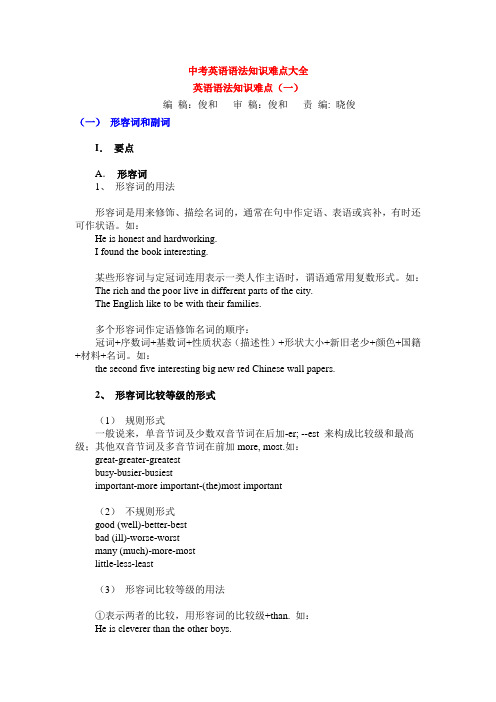
中考英语语法知识难点大全英语语法知识难点(一)编稿:俊和审稿:俊和责编: 晓俊(一)形容词和副词I.要点A.形容词1、形容词的用法形容词是用来修饰、描绘名词的,通常在句中作定语、表语或宾补,有时还可作状语。
如:He is honest and hardworking.I found the book interesting.某些形容词与定冠词连用表示一类人作主语时,谓语通常用复数形式。
如:The rich and the poor live in different parts of the city.The English like to be with their families.多个形容词作定语修饰名词的顺序:冠词+序数词+基数词+性质状态(描述性)+形状大小+新旧老少+颜色+国籍+材料+名词。
如:the second five interesting big new red Chinese wall papers.2、形容词比较等级的形式(1)规则形式一般说来,单音节词及少数双音节词在后加-er; --est 来构成比较级和最高级;其他双音节词及多音节词在前加more, most.如:great-greater-greatestbusy-busier-busiestimportant-more important-(the)most important(2)不规则形式good (well)-better-bestbad (ill)-worse-worstmany (much)-more-mostlittle-less-least(3)形容词比较等级的用法①表示两者的比较,用形容词的比较级+than. 如:He is cleverer than the other boys.This one is more beautiful than that one.②表示两者以上的比较,用"the +形容词最高级(+名词)+of(in) …"如:He is the cleverest boy in his class.③表示两者是同等程度,用"as +形容词原级+as". 如:He is as tall as I.I have as many books as you.④越… 越…例如:The more I learn, the happier I am.⑤ You can never be too careful. 越小心越好又如:You can never praise the teacher too highly.你怎么赞扬这个老师也不过分。
中考英语语法知识难点大全
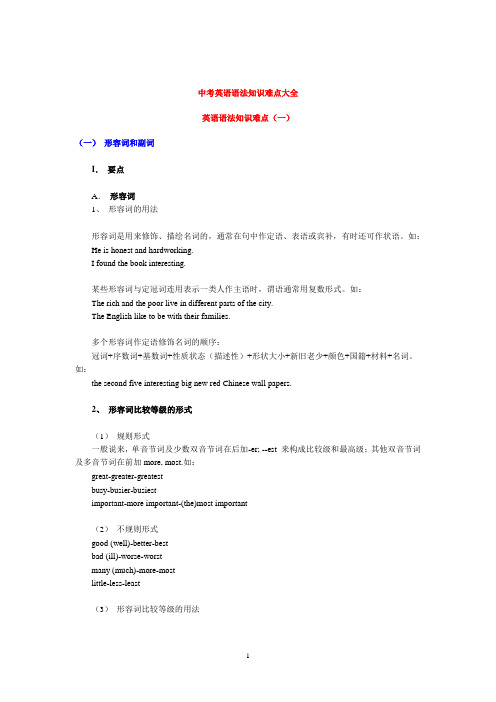
中考英语语法知识难点大全英语语法知识难点(一)(一)形容词和副词I.要点A.形容词1、形容词的用法形容词是用来修饰、描绘名词的,通常在句中作定语、表语或宾补,有时还可作状语。
如:He is honest and hardworking.I found the book interesting.某些形容词与定冠词连用表示一类人作主语时,谓语通常用复数形式。
如:The rich and the poor live in different parts of the city.The English like to be with their families.多个形容词作定语修饰名词的顺序:冠词+序数词+基数词+性质状态(描述性)+形状大小+新旧老少+颜色+国籍+材料+名词。
如:the second five interesting big new red Chinese wall papers.2、形容词比较等级的形式(1)规则形式一般说来,单音节词及少数双音节词在后加-er; --est 来构成比较级和最高级;其他双音节词及多音节词在前加more, most.如:great-greater-greatestbusy-busier-busiestimportant-more important-(the)most important(2)不规则形式good (well)-better-bestbad (ill)-worse-worstmany (much)-more-mostlittle-less-least(3)形容词比较等级的用法①表示两者的比较,用形容词的比较级+than. 如:He is cleverer than the other boys.This one is more beautiful than that one.②表示两者以上的比较,用"the +形容词最高级(+名词)+of(in) …"如:He is the cleverest boy in his class.③表示两者是同等程度,用"as +形容词原级+as". 如:He is as tall as I.I have as many books as you.④越… 越…例如:The more I learn, the happier I am.⑤You can never be too careful. 越小心越好又如:You can never praise the teacher too highly.你怎么赞扬这个老师也不过分。
初中英语语法知识难点大全

初中英语语法知识难点大全英语语法知识难点(一)(一)形容词和副词I.要点A.形容词1、形容词的用法形容词是用来修饰、描绘名词的,通常在句中作定语、表语或宾补,有时还可作状语。
如:He is honest and hard-working.I found the book interesting.某些形容词与定冠词连用表示一类人作主语时,谓语通常用复数形式。
如:The rich and the poor live in different parts of the city.The English like to be with their families.多个形容词作定语修饰名词的顺序:冠词+序数词+基数词+性质状态(描述性)+形状大小+新旧老少+颜色+国籍+材料+名词。
如:the second five interesting big new red Chinese wall papers.2、形容词比较等级的形式(1)规则形式一般说来,单音节词及少数双音节词在后加-er; --est 来构成比较级和最高级;其他双音节词及多音节词在前加more, most.如: great-greater-greatest busy-busier-busiest important-more important-(themost important(2)不规则形式good (well-better-best bad (ill-worse-worst many (much-more-most little-less-least(3)形容词比较等级的用法①表示两者的比较,用形容词的比较级+than. 如:He is cleverer than the other boys. This one is more beautiful than that one.②表示两者以上的比较,用"the +形容词最高级(+名词)+of(in …"如:He is the cleverest boy in his class.③表示两者是同等程度,用"as +形容词原级+as". 如:He is as tall as I.I have as many books as you.④越… 越… 例如:The more I learn, the happier I am.⑤ You can never be too careful. 越小心越好又如:You can never praise the teacher too highly. 你怎么赞扬这个老师也不过分。
中考英语语法知识难点大全
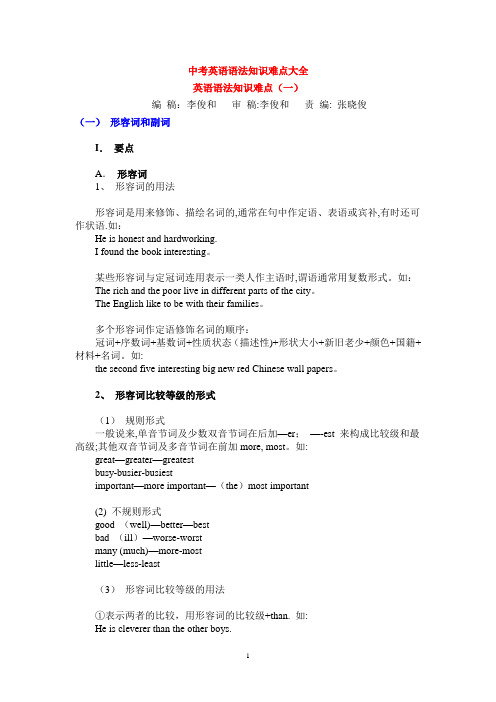
中考英语语法知识难点大全英语语法知识难点(一)编稿:李俊和审稿:李俊和责编: 张晓俊(一)形容词和副词I.要点A.形容词1、形容词的用法形容词是用来修饰、描绘名词的,通常在句中作定语、表语或宾补,有时还可作状语.如:He is honest and hardworking.I found the book interesting。
某些形容词与定冠词连用表示一类人作主语时,谓语通常用复数形式。
如:The rich and the poor live in different parts of the city。
The English like to be with their families。
多个形容词作定语修饰名词的顺序:冠词+序数词+基数词+性质状态(描述性)+形状大小+新旧老少+颜色+国籍+材料+名词。
如:the second five interesting big new red Chinese wall papers。
2、形容词比较等级的形式(1)规则形式一般说来,单音节词及少数双音节词在后加—er;—-est 来构成比较级和最高级;其他双音节词及多音节词在前加more, most。
如:great—greater—greatestbusy-busier-busiestimportant—more important—(the)most important(2) 不规则形式good (well)—better—bestbad (ill)—worse-worstmany (much)—more-mostlittle—less-least(3)形容词比较等级的用法①表示两者的比较,用形容词的比较级+than. 如:He is cleverer than the other boys.This one is more beautiful than that one。
②表示两者以上的比较,用"the +形容词最高级(+名词)+of(in)…"如:He is the cleverest boy in his class。
中考英语语法知识难点大全
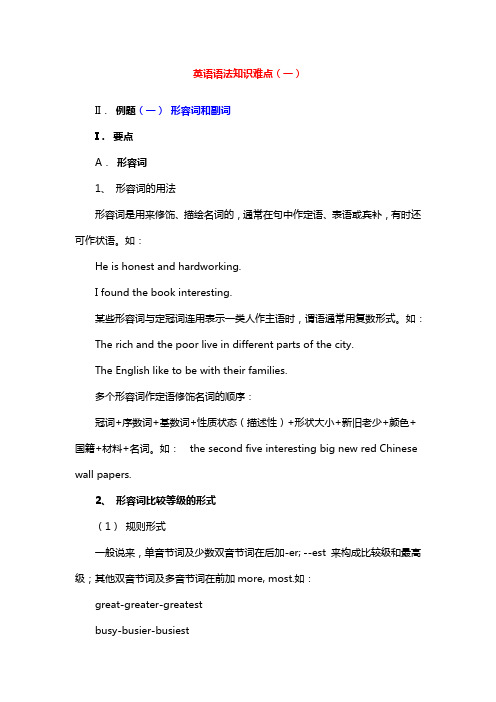
英语语法知识难点(一)II.例题(一)形容词和副词I.要点A.形容词1、形容词的用法形容词是用来修饰、描绘名词的,通常在句中作定语、表语或宾补,有时还可作状语。
如:He is honest and hardworking.I found the book interesting.某些形容词与定冠词连用表示一类人作主语时,谓语通常用复数形式。
如:The rich and the poor live in different parts of the city.The English like to be with their families.多个形容词作定语修饰名词的顺序:冠词+序数词+基数词+性质状态(描述性)+形状大小+新旧老少+颜色+国籍+材料+名词。
如:the second five interesting big new red Chinese wall papers.2、形容词比较等级的形式(1)规则形式一般说来,单音节词及少数双音节词在后加-er; --est 来构成比较级和最高级;其他双音节词及多音节词在前加more, most.如:great-greater-greatestbusy-busier-busiestimportant-more important-(the)most important(2)不规则形式good (well)-better-bestbad (ill)-worse-worstmany (much)-more-mostlittle-less-least(3)形容词比较等级的用法①表示两者的比较,用形容词的比较级+than. 如:He is cleverer than the other boys.This one is more beautiful than that one.②表示两者以上的比较,用"the +形容词最高级(+名词)+of(in) …"如:He is the cleverest boy in his class.③表示两者是同等程度,用"as +形容词原级+as". 如:He is as tall as I.I have as many books as you.④越… 越…例如:The more I learn, the happier I am.⑤ You can never be too careful. 越小心越好又如:You can never praise the teacher too highly.你怎么赞扬这个老师也不过分。
初中英语语法重难点进一步全面总结与归纳 (2)

Part Two
时态和语态
一般现在时
添加标题
定义:表示经常发生的动作或存在的状态
添加标题
用法:时间状语为always, usually, often, sometimes, ever y week (day, year, month…), once a week (day, year, month…), on Sundays (on Mondays …) 等
过去时态
定义:表示过去某个时间发生的动作或状态 构成:基本结构为“动词+ed”,不规则动词需特别记忆 用法:与现在时态和将来时态相比,过去时态需在时间状语中使用 注意事项:过去时态与现在时态在用法上有明显区别,需注意正确使用
将来时态
定义:表示未来 的动作或状态
构成: will/shall+动词 原形
主语+谓语+宾语: 宾语是动作的承受 者,完整的表达了 句子的意思。
主语+谓语+表语: 表语是对主语的描 述或补充,常出现 在系动词之后。
主语+谓语+宾语&整。
Part Four
非谓语动词和虚拟语气
不定式和动名词
不定式:表示目 的、结果或原因
动词的时态和语态
时态:描述动作发生的时间,如现在、过去、将来等
语态:描述动作与主语之间的关系,如主动、被动等
常用介词和连词的用法
常用介词:in、on、over、under等
常用连词:and、but、or、so等
用法举例:in表示在某个范围之内,on 表示在某个物体之上,over表示在某个 物体之上,under表示在某个物体之下
特点:具有名词的语法功能, 如作主语、宾语、表语等
中考英语语法知识难点大全

中考英语语法知识难点大全英语语法知识难点(一)编稿:俊和审稿:俊和责编: 晓俊(一)形容词和副词I.要点A.形容词1、形容词的用法形容词是用来修饰、描绘名词的,通常在句中作定语、表语或宾补,有时还可作状语。
如:He is honest and hardworking.I found the book interesting.某些形容词与定冠词连用表示一类人作主语时,谓语通常用复数形式。
如:The rich and the poor live in different parts of the city.The English like to be with their families.多个形容词作定语修饰名词的顺序:冠词+序数词+基数词+性质状态(描述性)+形状大小+新旧老少+颜色+国籍+材料+名词。
如:the second five interesting big new red Chinese wall papers.2、形容词比较等级的形式(1)规则形式一般说来,单音节词与少数双音节词在后加-er; --est 来构成比较级和最高级;其他双音节词与多音节词在前加more, most.如:great-greater-greatestbusy-busier-busiestimportant-more important-(the)most important(2)不规则形式good (well)-better-bestbad (ill)-worse-worstmany (much)-more-mostlittle-less-least(3)形容词比较等级的用法①表示两者的比较,用形容词的比较级+than. 如:He is cleverer than the other boys.This one is more beautiful than that one.②表示两者以上的比较,用"the +形容词最高级(+名词)+of(in) …"如:He is the cleverest boy in his class.③表示两者是同等程度,用"as +形容词原级+as". 如:He is as tall as I.I have as many books as you.④越… 越…例如:The more I learn, the happier I am.⑤ You can never be too careful. 越小心越好又如:You can never praise the teacher too highly.你怎么赞扬这个老师也不过分。
中考英语语法知识难点大全

中考英语语法知识难点大全英语语法知识难点(一)(一)形容词和副词I.要点A.形容词1、形容词的用法形容词是用来修饰、描绘名词的,通常在句中作定语、表语或宾补,有时还可作状语。
如:He is honest and hardworking. I found the book interesting.某些形容词与定冠词连用表示一类人作主语时,谓语通常用复数形式。
如:The rich and the poor live in different parts of the city. The English like to be with their families.多个形容词作定语修饰名词的顺序:冠词+序数词+基数词+性质状态(描述性)+形状大小+新旧老少+颜色+国籍+材料+名词。
如:the second five interesting big new red Chinese wall papers.2、形容词比较等级的形式(1)规则形式一般说来,单音节词及少数双音节词在后加-er; --est 来构成比较级和最高级;其他双音节词及多音节词在前加more, most.如:great-greater-greatest busy-busier-busiest important-more important-(the)most important(2)不规则形式good (well)-better-best bad (ill)-worse-worst many (much)-more-most little-less-least(3)形容词比较等级的用法①表示两者的比较,用形容词的比较级+than. 如:He is cleverer than the other boys.This one is more beautiful than that one.②表示两者以上的比较,用"the +形容词最高级(+名词)+of(in) …"如:He is the cleverest boy in his class.③表示两者是同等程度,用"as +形容词原级+as". 如:He is as tall as I.I have as many books as you.④越… 越…例如:The more I learn, the happier I am.⑤You can never be too careful. 越小心越好又如:You can never praise the teacher too highly. 你怎么赞扬这个老师也不过分。
中考英语语法难点汇总精品文档10页
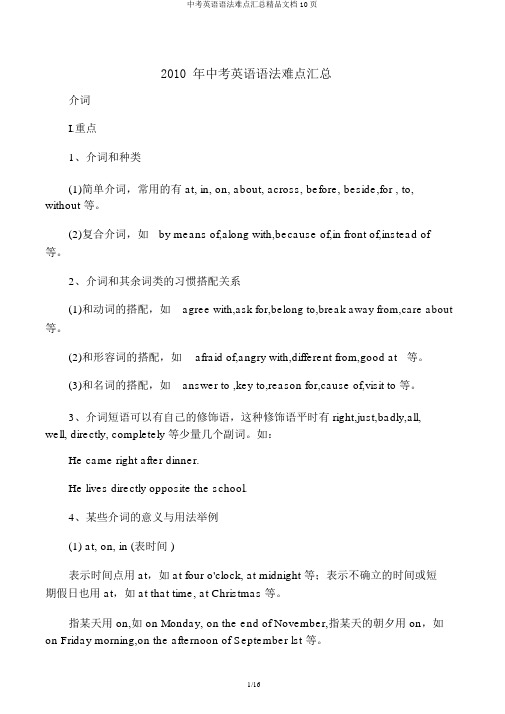
2010 年中考英语语法难点汇总介词I.重点1、介词和种类(1)简单介词,常用的有 at, in, on, about, across, before, beside,for , to, without 等。
(2)复合介词,如by means of,along with,because of,in front of,instead of 等。
2、介词和其余词类的习惯搭配关系(1)和动词的搭配,如agree with,ask for,belong to,break away from,care about 等。
(2)和形容词的搭配,如afraid of,angry with,different from,good at等。
(3)和名词的搭配,如answer to ,key to,reason for,cause of,visit to 等。
3、介词短语可以有自己的修饰语,这种修饰语平时有 right,just,badly,all, well, directly, completely 等少量几个副词。
如:He came right after dinner.He lives directly opposite the school.4、某些介词的意义与用法举例(1) at, on, in (表时间 )表示时间点用 at,如 at four o'clock, at midnight 等;表示不确立的时间或短期假日也用 at,如 at that time, at Christmas 等。
指某天用 on,如 on Monday, on the end of November,指某天的朝夕用 on,如on Friday morning,on the afternoon of September lst 等。
指于或短于一天的段用 in,如 in the afternoon, in February, in Summer, in 1999 等。
初中英语语法知识难点大全3
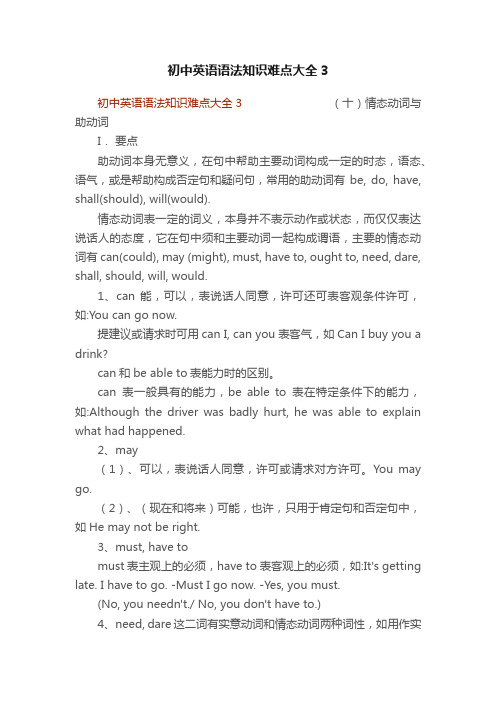
初中英语语法知识难点大全3初中英语语法知识难点大全3 (十)情态动词与助动词I.要点助动词本身无意义,在句中帮助主要动词构成一定的时态,语态、语气,或是帮助构成否定句和疑问句,常用的助动词有be, do, have, shall(should), will(would).情态动词表一定的词义,本身并不表示动作或状态,而仅仅表达说话人的态度,它在句中须和主要动词一起构成谓语,主要的情态动词有can(could), may (might), must, have to, ought to, need, dare, shall, should, will, would.1、can 能,可以,表说话人同意,许可还可表客观条件许可,如:You can go now.提建议或请求时可用can I, can you表客气,如Can I buy you a drink?can和be able to表能力时的区别。
can表一般具有的能力,be able to表在特定条件下的能力,如:Although the driver was badly hurt, he was able to explain what had happened.2、may(1)、可以,表说话人同意,许可或请求对方许可。
You may go.(2)、(现在和将来)可能,也许,只用于肯定句和否定句中,如He may not be right.3、must, have tomust表主观上的必须,have to表客观上的必须,如:It's getting late. I have to go. -Must I go now. -Yes, you must.(No, you needn't./ No, you don't have to.)4、need, dare这二词有实意动词和情态动词两种词性,如用作实意动词后接动词不定式to do,如用作情态动词后接动词原形。
初中英语语法有哪些重点难点?
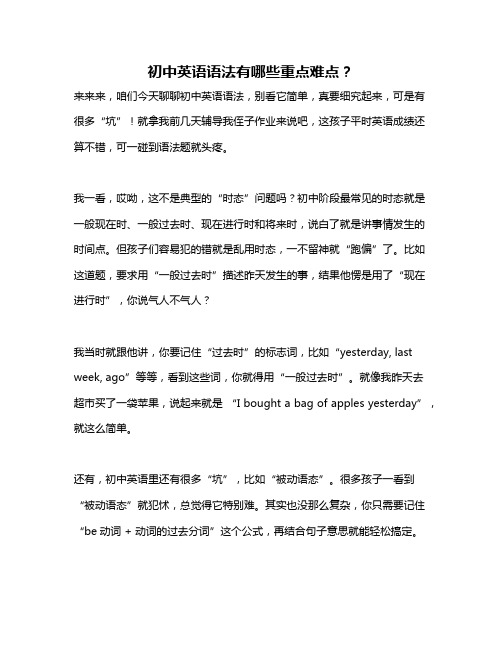
初中英语语法有哪些重点难点?
来来来,咱们今天聊聊初中英语语法,别看它简单,真要细究起来,可是有很多“坑”!就拿我前几天辅导我侄子作业来说吧,这孩子平时英语成绩还算不错,可一碰到语法题就头疼。
我一看,哎呦,这不是典型的“时态”问题吗?初中阶段最常见的时态就是一般现在时、一般过去时、现在进行时和将来时,说白了就是讲事情发生的时间点。
但孩子们容易犯的错就是乱用时态,一不留神就“跑偏”了。
比如这道题,要求用“一般过去时”描述昨天发生的事,结果他愣是用了“现在进行时”,你说气人不气人?
我当时就跟他讲,你要记住“过去时”的标志词,比如“yesterday, last week, ago”等等,看到这些词,你就得用“一般过去时”。
就像我昨天去超市买了一袋苹果,说起来就是“I bought a bag of apples yesterday”,就这么简单。
还有,初中英语里还有很多“坑”,比如“被动语态”。
很多孩子一看到“被动语态”就犯怵,总觉得它特别难。
其实也没那么复杂,你只需要记住“be动词 + 动词的过去分词”这个公式,再结合句子意思就能轻松搞定。
就像我那侄子写的作文,他写“The door was opened by me”,翻译成中文就是“门被我打开了”,就简单明了嘛~
当然了,最关键还得是多练习,就像我每次都跟他说,要多做题,多总结,才能真正把语法知识融会贯通。
就像我当年学英语,也是靠着大量的练习才掌握了各种语法规则,现在回头想想,那可真是“苦尽甘来”啊!
所以说,想要学好初中英语语法,关键在于多理解、多练习,别怕出错,只要不断总结经验,你一定能克服这些“坑”,成为英语语法小达人!。
1初中英语语法知识难点汇总
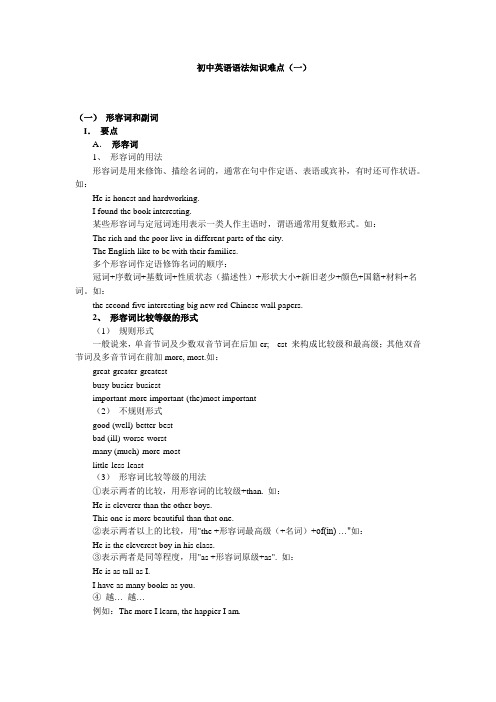
初中英语语法知识难点(一)(一)形容词和副词I.要点A.形容词1、形容词的用法形容词是用来修饰、描绘名词的,通常在句中作定语、表语或宾补,有时还可作状语。
如:He is honest and hardworking.I found the book interesting.某些形容词与定冠词连用表示一类人作主语时,谓语通常用复数形式。
如:The rich and the poor live in different parts of the city.The English like to be with their families.多个形容词作定语修饰名词的顺序:冠词+序数词+基数词+性质状态(描述性)+形状大小+新旧老少+颜色+国籍+材料+名词。
如:the second five interesting big new red Chinese wall papers.2、形容词比较等级的形式(1)规则形式一般说来,单音节词及少数双音节词在后加-er; --est 来构成比较级和最高级;其他双音节词及多音节词在前加more, most.如:great-greater-greatestbusy-busier-busiestimportant-more important-(the)most important(2)不规则形式good (well)-better-bestbad (ill)-worse-worstmany (much)-more-mostlittle-less-least(3)形容词比较等级的用法①表示两者的比较,用形容词的比较级+than. 如:He is cleverer than the other boys.This one is more beautiful than that one.②表示两者以上的比较,用"the +形容词最高级(+名词)+of(in) …"如:He is the cleverest boy in his class.③表示两者是同等程度,用"as +形容词原级+as". 如:He is as tall as I.I have as many books as you.④越… 越…例如:The more I learn, the happier I am.⑤You can never be too careful. 越小心越好又如:You can never praise the teacher too highly.你怎么赞扬这个老师也不过分。
初中英语语法知识难点
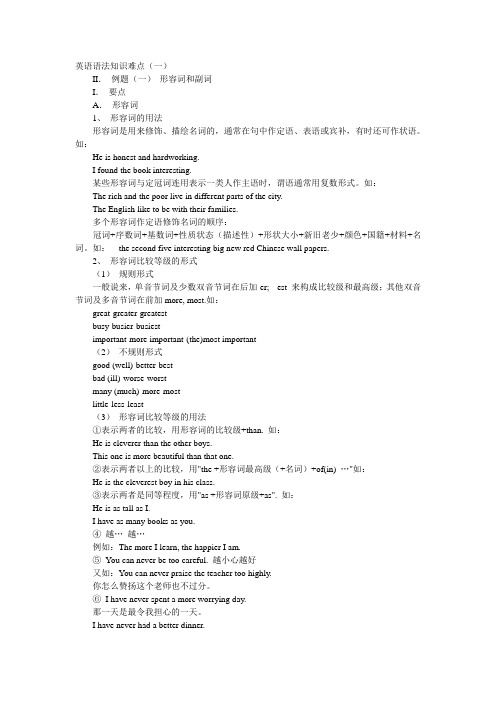
英语语法知识难点(一)II.例题(一)形容词和副词I.要点A.形容词1、形容词的用法形容词是用来修饰、描绘名词的,通常在句中作定语、表语或宾补,有时还可作状语。
如:He is honest and hardworking.I found the book interesting.某些形容词与定冠词连用表示一类人作主语时,谓语通常用复数形式。
如:The rich and the poor live in different parts of the city.The English like to be with their families.多个形容词作定语修饰名词的顺序:冠词+序数词+基数词+性质状态(描述性)+形状大小+新旧老少+颜色+国籍+材料+名词。
如:the second five interesting big new red Chinese wall papers.2、形容词比较等级的形式(1)规则形式一般说来,单音节词及少数双音节词在后加-er; --est 来构成比较级和最高级;其他双音节词及多音节词在前加more, most.如:great-greater-greatestbusy-busier-busiestimportant-more important-(the)most important(2)不规则形式good (well)-better-bestbad (ill)-worse-worstmany (much)-more-mostlittle-less-least(3)形容词比较等级的用法①表示两者的比较,用形容词的比较级+than. 如:He is cleverer than the other boys.This one is more beautiful than that one.②表示两者以上的比较,用"the +形容词最高级(+名词)+of(in) …"如:He is the cleverest boy in his class.③表示两者是同等程度,用"as +形容词原级+as". 如:He is as tall as I.I have as many books as you.④越…越…例如:The more I learn, the happier I am.⑤You can never be too careful. 越小心越好又如:You can never praise the teacher too highly.你怎么赞扬这个老师也不过分。
中考英语语法知识难点大全
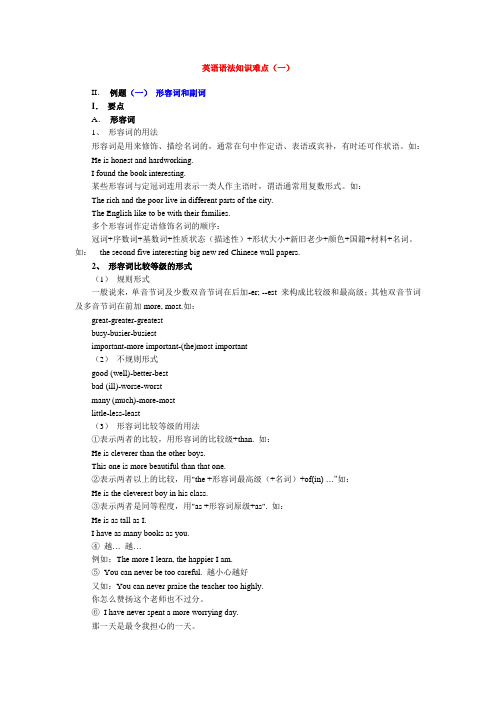
英语语法知识难点(一)II.例题(一)形容词和副词I.要点A.形容词1、形容词的用法形容词是用来修饰、描绘名词的,通常在句中作定语、表语或宾补,有时还可作状语。
如:He is honest and hardworking.I found the book interesting.某些形容词与定冠词连用表示一类人作主语时,谓语通常用复数形式。
如:The rich and the poor live in different parts of the city.The English like to be with their families.多个形容词作定语修饰名词的顺序:冠词+序数词+基数词+性质状态(描述性)+形状大小+新旧老少+颜色+国籍+材料+名词。
如:the second five interesting big new red Chinese wall papers.2、形容词比较等级的形式(1)规则形式一般说来,单音节词及少数双音节词在后加-er; --est 来构成比较级和最高级;其他双音节词及多音节词在前加more, most.如:great-greater-greatestbusy-busier-busiestimportant-more important-(the)most important(2)不规则形式good (well)-better-bestbad (ill)-worse-worstmany (much)-more-mostlittle-less-least(3)形容词比较等级的用法①表示两者的比较,用形容词的比较级+than. 如:He is cleverer than the other boys.This one is more beautiful than that one.②表示两者以上的比较,用"the +形容词最高级(+名词)+of(in) …"如:He is the cleverest boy in his class.③表示两者是同等程度,用"as +形容词原级+as". 如:He is as tall as I.I have as many books as you.④越… 越…例如:The more I learn, the happier I am.⑤You can never be too careful. 越小心越好又如:You can never praise the teacher too highly.你怎么赞扬这个老师也不过分。
- 1、下载文档前请自行甄别文档内容的完整性,平台不提供额外的编辑、内容补充、找答案等附加服务。
- 2、"仅部分预览"的文档,不可在线预览部分如存在完整性等问题,可反馈申请退款(可完整预览的文档不适用该条件!)。
- 3、如文档侵犯您的权益,请联系客服反馈,我们会尽快为您处理(人工客服工作时间:9:00-18:30)。
• 动词不同 (实义动词 , 系动词), • 否定式不同: +助动词, 不用. • 表语可以是形容词,宾语不行. 只有宾语有补
足语
句子成分:
英语句子成分分为七种
主语、谓语、宾语、定语、状语、表语、宾语 补足语。
1、I’m Miss Yu. (主语)
2、Tom cleans his bedroom every day. (谓语)
2. 我和我的父母下个星期天要去看我的 爷爷奶奶。
My parents and I will/are going to see my grandparents next Sunday.
案例二:
① I like music that I can dance to.
先行词 指物 关系代词 作宾语 可省 ② I like musicians who write their own songs.
初中英语语法难点 及教学策略
高涛
一、引 言
英语作为语言的一种,其学习也要遵 循它的基本规律。
英语语法能力的掌握是掌握其它诸多 能力的基础。
有了一定的语法基础,对于学生能 准确的表达、正确的理解, 有着 至关重要的作用。
我在初中英语语法教学中的一些方法
演绎归纳穿插教学法 比较教学法 图表教学法 表格教学法 口诀教学法
区别:sometimes, some times, sometime, some time
口诀: 有“s” 是“有时”, 无“s” 是“某时”, 有“s” 分开“好几次” , 无“s” 分开“一段时”
二、英语句子结构 和英语句子成分
讲解及练习
1.She came.
主 + 不及物动词
2.She likes English。
beside
3. 图表教学法
behind
on
near
iunnder
In front of
4. 表格教学法:
第一 人称
主格 I
形容词性 名词性
宾格
物主代词 物主代词
me
We us
第二 人称
第三 人称
You you
She Her He Him It it
They them
反身代词
5. 口诀教学法:
1)名词由单数变为复数,以o结尾的词有: Negro, hero, tomato, potato.我们可以这样 说:黑人,英雄吃土豆和西红柿。 2)名词由单数变为复数,以f (fe)结尾的词有: leaf, half, wife, knife, self, wolf, thief.我们 可以这样说:树叶,半数自己数,妻子拿刀 去割粮,然后窜出一只狼,就像强盗逃命忙。 3)基数词变序数词的口诀: 一,二,三要全变,八去t, 九去e, ve要用f替, y变成ie,th最后加上去,若是碰到几十几,只 变个位就可以。
主 + 动词 + 宾语
+宾语补足语
read the book. 主 + 动词 +宾语 +宾语补足语
英语简单句的五种基本句型
1.S+V+O 主+谓+宾
2.S+V
主+谓(不及物动词)
3.S+V+P 主+系+表
4.S+V+O+O 主+谓+双宾语
5.S+V+O+C 主+谓+宾语+宾语补足语
先行词 指人 关系代词 作主语 不可省 ③ She likes singers who sing the words clearly.
先行词 指人 关系代词 作主语 不可省 ④ He doesn’t like songs that are too loud.
先行词 指物 关系代词 作主语 不可省
2. 比较教学法:
3、My name is Yu Yan . (表语)
4、He can speak English (. 宾语) He gave me a gift . (间宾)(直宾)
5. He gave a gift to me. (直宾)(间宾)
5、Wuhan is a big city . (定语) 6、He works hard . (状语)
案例三:
1. If it rains tomorrow, we will stay at home. 2. If I am free this night, I can help you. If+主语+ V原/现三单 ,主语 + Will/can + V原
3. If I were you, I would study English well. 4. If he were a doctor, he could helpthe sick boy. If+主语+ V过去式 ,主语 + would/could + V原
7 They usually keep their classroom clean.
(宾语补足语)
8. He often helps me do my homework.
(宾语补足语)
9. The teacher wanted me to learn English all by
myself.
(宾语补足语)
1.演绎,归纳穿插教学法:
案例一: 语法:一般将来时 一、概念: 即将发生的动作或存在的状态。 二、构成: 主语+will /be going to +V原+其它 三、标志词: tomorrow next in +将来的段时间等
例如:
1. 我们明天要去看电影。 We will go to see a movie tomorrow.
主 + 及物动词 + 宾语
3.She is hungry.
主+系+表
4.She gave Tom a gift.
主 +及物动词+ 间接宾语+直接宾语
♥ 5.She bought a book for me. 主 + 动词 +直接宾语 +间接宾语
♥ 6.She makes her mother angry
• We saw you. 否:We didn’t see you. • We did our homework. • You are beautiful 否:You aren’t beautiful. • You seem worried. • You are a student.
相同点:
都有三部分,主语也一样.时态一致
